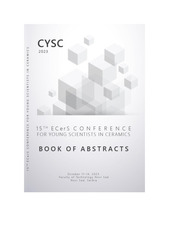Приказ основних података о документу
Development and characterization of composites for bone tissue engineering with the aid of biomimetic bioreactors
| dc.creator | Zvicer, Jovana | |
| dc.creator | Stojkovska, Jasmina | |
| dc.creator | Obradović, Bojana | |
| dc.date.accessioned | 2023-12-13T21:02:54Z | |
| dc.date.available | 2023-12-13T21:02:54Z | |
| dc.date.issued | 2023 | |
| dc.identifier.isbn | 978-86-6253-174-2 | |
| dc.identifier.uri | http://TechnoRep.tmf.bg.ac.rs/handle/123456789/6955 | |
| dc.description.abstract | Developing new biomaterials for bone tissue engineering is of vital importance due to the increasing demand for bone transplants resulting from various causes, such as trauma, tumors, infection, and genetic conditions. To address this persistent need, biomaterials for bone tissue engineering must fulfil several critical requirements, such as mimicking the hierarchical structure of complex bone tissue composed of organic and inorganic components, possessing suitable mechanical properties, pore size, and porosity, as well as an appropriate degradation rate. Our research group has successfully developed two promising biomaterials for bone tissue engineering, utilizing a combination of bioactive glass (BAG) or β-tricalcium phosphate (β-TCP) - undoped or doped with Mg2+, and different natural polymers, such as gellan gum (GG) and alginate (ALG). Obtained scaffolds were assessed in terms of porosity and pore size distribution, and mechanical properties under physiological levels of mechanical compression (337.5 μm/s loading rate, 10% strain) using a dynamic compression bioreactor coupled with medium perfusion over a 14-day period. The mechanical properties of the β-TCP-ALG scaffolds were influenced by the composition of calcium phosphate fillers, with improvements observed as Ca2+ concentration increased while Mg2+ concentration decreased. These properties were significantly higher compared to the mechanical properties of BAG-GG scaffolds. Bioactivity of the scaffolds was evaluated under static and biomimetic conditions in the perfusion bioreactor, with a continuous flow of simulated body fluid (SBF) at a superficial velocity of 400 µm/s. The formation of hydroxyapatite (HAp) within the BAG-based scaffolds was studied for 14 days, while for β-TCP-based scaffolds, the studies continued for 28 days. The results revealed a remarkable increase in HAp formation under bioreactor conditions compared to static controls in both types of scaffolds, with HAp crystals exhibiting a more uniform distribution and a distinctive cauliflower-like morphology throughout the scaffolds. However, bioactivity was more profound for the BAG-GG scaffolds compared to β-TCP-ALG scaffolds due to additional gelation of alginate around the incorporated fillers. Physiologically relevant characterization with the aid of biomimetic bioreactors has unveiled the promising potential of novel composite scaffolds for bone tissue engineering, while also highlighting the importance of carefully balancing different scaffold characteristics, such as mechanical strength and bioactivity, to develop optimal scaffolds tailored for specific applications. | sr |
| dc.language.iso | en | sr |
| dc.publisher | Novi Sad : Faculty of Technology | sr |
| dc.rights | openAccess | sr |
| dc.rights.uri | https://creativecommons.org/licenses/by-nc-nd/4.0/ | |
| dc.source | Programme and The Book of Abstracts / 15th ECerS Conference for Young Scientists in Ceramics, CYSC-2023, October 11-14, 2023, Novi Sad, Serbia | sr |
| dc.title | Development and characterization of composites for bone tissue engineering with the aid of biomimetic bioreactors | sr |
| dc.type | conferenceObject | sr |
| dc.rights.license | BY-NC-ND | sr |
| dc.citation.spage | 27 | |
| dc.identifier.fulltext | http://TechnoRep.tmf.bg.ac.rs/bitstream/id/19029/Development_and_characterization_pub_2023.pdf | |
| dc.identifier.rcub | https://hdl.handle.net/21.15107/rcub_technorep_6955 | |
| dc.type.version | publishedVersion | sr |

